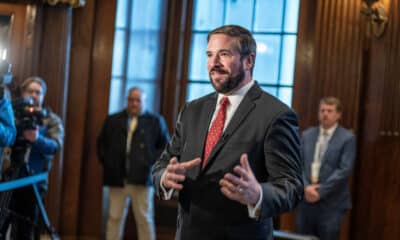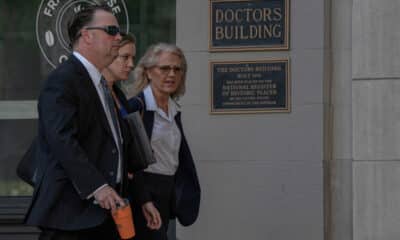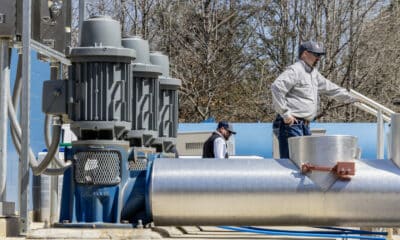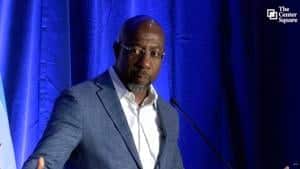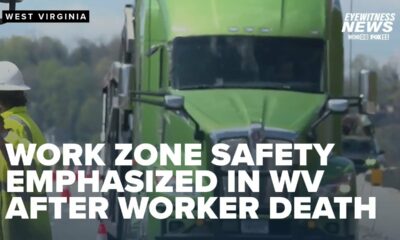News from the South - West Virginia News Feed
FEMA’s refusal to help some West Virginia counties just a taste of what’s to come
by Leann Ray, West Virginia Watch
April 29, 2025
Last week, West Virginia Watch reporter Amelia Ferrell Knisely traveled to McDowell County to talk to residents about recovery efforts after the mid-February floods.
She found that many people still have soggy carpets and wet basements after more than two months. Houses are filled with mold. Trash is piled up outside. Some residents say they haven’t seen anyone from the state or federal government in their small towns offering help.
And McDowell is one of the few counties that actually received federal funding for flood response.
In late February, the federal government approved Gov. Patrick Morrisey’s request for federal aid. The Federal Emergency Management Agency has so far approved nearly 3,500 applications for individual assistance, and more than $25 million has been awarded to residents in Logan, McDowell, Mercer, Mingo, Raleigh, Wayne and Wyoming counties.
Residents who receive that money can use it to cover the costs of temporary housing and home repairs.
About 94% of West Virginia communities are considered “Special Flood Hazard Areas,” which means the more than 84,000 structures in those areas are at a high risk of flooding, according to a 2023 report by researchers at West Virginia University.
However, President Donald Trump has suggested that FEMA, which is the only agency currently that administers disaster relief funds, might “go away.”
Last week it was announced that Elon Musk’s Department of Government Efficiency would cut 1,000 employees — or 20% of the workforce — from FEMA, just ahead of hurricane season.
On Wednesday, Morrisey announced that FEMA denied individual assistance grants to Boone, Cabell, Greenbrier, Kanawha, Lincoln, Monroe and Summers counties, and public assistance grants in Cabell and Kanawha counties for the February floods.
“Despite today’s notification, I am grateful to the Trump Administration for their strong support for Southern West Virginia’s recovery following the February floods,” Morrisey said in a statement.
We know you’re not a native West Virginian, governor, but please stand up for your adopted state.
Alex Brown from Stateline, one of West Virginia Watch’s sister newsrooms, reached out to the White House about states being denied FEMA funding, and received a statement that said the agency is focused on “truly catastrophic disasters,” and that states need to have a better “appetite to own the problem.”
West Virginia has no appetite, as shown during the legislative session.
On April 4, about three weeks after the devastating February floods, Del. Sean Hornbuckle, D-Cabell, proposed adding $50 million to the state budget for flood prevention.
“We have the ability to do something earthly,” Hornbuckle said. “The power that we have — not just the divine power — but with a button and a pen that we all have to help out neighbors in the great state of West Virginia.”
The amendment was rejected 75-19.
Remember the 2016 floods — the deadliest in the state’s history? Former Gov. Earl Ray Tomblin, a Democrat born in Logan County, declared a state of emergency for 44 of the state’s 55 counties.
Since November 2019, FEMA has given West Virginia more than $424 million in funding in response to the 2016 floods. More than $42 million was given to 4,949 individuals and families, and more than $172.8 million was given to local and state governments and some nonprofits. FEMA also provided more than $209.8 million to replace Herbert Hoover High, Richwood Middle, Richwood High, Summersville Middle and to relocate Clendenin Elementary.
Herbert Hoover High School was destroyed, and students were taught in portable classrooms until their new school was completed in fall 2023. Clendenin Elementary School didn’t reopen until fall 2024. Construction hasn’t started on the schools destroyed in Nicholas County.
In response to that flood, the West Virginia Legislature created the State Resiliency Office. Its purpose is to “Minimize the loss of life and property, maintain economic stability, and improve recovery time by coordinating with stakeholders to implement disaster resilient strategies.
The state Legislature created the West Virginia Disaster Recovery Trust Fund in 2023 with Senate Bill 677. The fund sits empty. No money was allocated to that fund during the 2024 legislative session. The FY 2026 budget, which Morrisey has signed, doesn’t include any money for the fund either.
There were only three bills related to flooding during the session — House Bill 2858 and Senate Bill 502 were the same bill, meant to allow counties to regulate floodplains under National Flood Insurance Program guidelines. They both died. House Bill 3502, sponsored by Hornbuckle, would have allowed a one-time allocation of $100 million from the state revenue shortfall fund and $150 million from the state’s income tax revenue fund for the West Virginia Flood Resiliency Trust Fund. It died in the House Government Organization.
West Virginia needs FEMA, but with FEMA potentially out of the picture, it’s time the state whet its appetite and take a bite out of the problem.
Morrisey has already said he plans to call a special session this summer to deal with the Public Employees Insurance Agency and education funding. Sounds like the perfect time and a good use of tax payer money to move some funding over to the West Virginia Disaster Recovery Trust Fund.
GET THE MORNING HEADLINES.
West Virginia Watch is part of States Newsroom, a nonprofit news network supported by grants and a coalition of donors as a 501c(3) public charity. West Virginia Watch maintains editorial independence. Contact Editor Leann Ray for questions: info@westvirginiawatch.com.
The post FEMA’s refusal to help some West Virginia counties just a taste of what’s to come appeared first on westvirginiawatch.com
Note: The following A.I. based commentary is not part of the original article, reproduced above, but is offered in the hopes that it will promote greater media literacy and critical thinking, by making any potential bias more visible to the reader –Staff Editor.
Political Bias Rating: Center-Left
This content reflects a center-left political bias as it highlights government and federal aid shortcomings in disaster response and recovery, particularly criticizing Republican leadership and policies, such as those associated with former President Trump and West Virginia Governor Morrisey. It underscores the need for more proactive state intervention and funding to support vulnerable communities, especially in the context of disaster resilience. The critique of budget decisions and FEMA staff cuts aligns with a perspective that supports stronger public sector involvement and social responsibility, typical of center-left viewpoints, without veering into extreme or partisan language.
News from the South - West Virginia News Feed
Couple sentenced in historic human trafficking case intend to appeal convictions
SUMMARY: Jeannie White Feather and Donald Lance, sentenced to over 100 years for human trafficking and related charges, are set to appeal their convictions. During a recent court hearing, their defense attorneys indicated intentions to seek a higher court review due to possible legal errors. While the appeal process is underway, two minor misdemeanor charges for false swearing were dismissed since their sentences are already severe. The case, notable for being the first successful human trafficking prosecution in the state, originated from the discovery of their adopted children living in deplorable conditions.

Jeanne Whitefeather and Donald Lantz appeared virtually from prison in their first hearing since they were each sentenced to more than 100 years in prison, but as it was pointed out in court, the clock is ticking for them to appeal their case.
FULL STORY: https://wchstv.com/news/local/couple-sentenced-in-historic-human-trafficking-case-intend-to-appeal-convictions
_________________________________________
For the latest local and national news, visit our website: https://wchstv.com/
Sign up for our newsletter: https://wchstv.com/sign-up
Follow WCHS-TV on social media:
Facebook: https://www.facebook.com/eyewitnessnewscharleston/
Twitter: https://twitter.com/wchs8fox11
Instagram: https://www.instagram.com/wchs8fox11/
News from the South - West Virginia News Feed
Pope Francis and the legacy he leaves behind
SUMMARY: Pope Francis, the first Latin American pontiff, left a significant legacy, marked by his unorthodox approach to leadership and his focus on humility. He was known for his calls for peace, particularly in war-torn Gaza, where he forged a strong bond with local priests. Throughout his papacy, he emphasized simplicity, evident in his choice of a simple wooden coffin and unadorned burial tomb. Francis also took a strong stance on social justice, criticizing rising anti-Semitism and advocating for the release of Israeli hostages. His death has left a lasting impact on the Catholic Church and the global community.

VATICAN CITY (TNND) — The Vatican kept its doors open all night Wednesday due to the tens of thousands of mourners lined up to see Pope Francis lying in state inside St. Peter’s Basilica.
#Pope #PopeFrancis #Vatican #RIP #CatholicChurch #Faith #ChurchNews #PapalLegacy #Christianity #ReligiousNews #BreakingNews #PopePassesAway #GlobalReactions #InMemoriam #PapalHistory
_________________________________________
For the latest local and national news, visit our website: https://wchstv.com/
Sign up for our newsletter: https://wchstv.com/sign-up
Follow WCHS-TV on social media:
Facebook: https://www.facebook.com/eyewitnessnewscharleston/
Twitter: https://twitter.com/wchs8fox11
Instagram: https://www.instagram.com/wchs8fox11/
News from the South - West Virginia News Feed
Tech-related tariffs remain uncertain, but prepare for cost hikes, experts say
by Paige Gross, West Virginia Watch
April 25, 2025
The price of technology goods and services in the U.S. will likely rise in the next few months, experts say, as the White House continues to shift its strategy on tariffs for imported electronic hardware.
After initial reports that Chinese goods would receive as high as a 145% tariff, President Donald Trump said on April 13 that electronics like smartphones, computers and semiconductors — chips that process, power and transmit information — would be exempt. But Trump said later that day that imported semiconductors, and the electronics they’re embedded in, will likely be facing their own tariff structure in the coming weeks.
In tandem with Trump’s announcement, the U.S. Department of Commerce announced an official investigation into semiconductor imports, aiming to study the national security implications of importing manufacturing equipment and derivative products. The move is likely two-fold, tech experts say — Trump’s aim with foreign tariffs is to pressure American manufacturers to make more goods in U.S. facilities.
But his administration is also likely looking for cybersecurity risks that could be introduced through foreign manufacturing, like in compromised operating systems, embedded malicious code, or flawed designs, said Derek Lemke, senior vice president of product level intelligence at risk management firm Exiger.
“They power everything from advanced weapons systems and critical infrastructure to smartphones and laptops,” Lemke said. “Many of these components are manufactured abroad, often in regions with rising geopolitical tensions or limited transparency into supply chain practices.”
The U.S. is currently upping its manufacturing of semiconductors. It produced about 10% of the world’s semiconductors in 2022, and is projected to reach 14% by 2032 with the additional funding and infrastructure provided by the CHIPS and Science Act, passed during the Biden administration. But while many advanced chips are designed by American companies like Nvidia, Apple, Qualcomm and AMD, they are manufactured in Taiwan, which is currently negotiating tariff deals with the U.S.
Many electronics involve manufacturing processes from all over the world, making the tariff structure involved a complicated one. And while it’s a good idea for Americans to manufacture more of their semiconductors to diversify the global supply chain of chips, the country is nowhere near prepared to make as many as we need, said Nikolas Guggenberger, an assistant professor of law with a focus on antitrust, law and technology, privacy, and regulation at The University of Houston Law Center.
Guggenberger called semiconductor manufacturing “among the most complex industrial processes on Earth,” which would require years of planning, training and billions in investment for the U.S. to become a leader.
While the U.S. awaits more clarity over tariffs on electronic goods and the findings of the semiconductor probe, Guggenberger and Lemke say that American consumers should prepare themselves for higher prices on smartphones, laptops and other personal devices. Because semiconductors are used in so many everyday products, those price hikes could seep into wider spending, Guggenberger said.
“From a computer to everyday devices, like a garage opener, or a toaster,” he said. “It’s everything, it’s absolutely everything.”
Guggenberger said there’s a possibility that very high tariffs could also lead to a pause or slowdown in manufacturing in general, meaning consumers may see emptier shelves or a backlog on products in a few months.
Those on the software side of the tech industry will feel the effects, too, Lemke said. Software companies, AI developers and cybersecurity experts all rely on computing power from chip hardware, and disruption in the supply chain could slow innovation in these businesses, he said.
Even just the discussion of tariffs is having a ripple effect through the tech sector, Lemke said. Companies are having to evaluate their supply chains, their sourcing and maybe stockpile some components to their products.
“The uncertainty alone is enough to influence pricing, procurement strategies and investment decisions across the tech ecosystem,” Lemke said.
West Virginia Watch is part of States Newsroom, a nonprofit news network supported by grants and a coalition of donors as a 501c(3) public charity. West Virginia Watch maintains editorial independence. Contact Editor Leann Ray for questions: info@westvirginiawatch.com.
The post Tech-related tariffs remain uncertain, but prepare for cost hikes, experts say appeared first on westvirginiawatch.com
Note: The following A.I. based commentary is not part of the original article, reproduced above, but is offered in the hopes that it will promote greater media literacy and critical thinking, by making any potential bias more visible to the reader –Staff Editor.
Political Bias Rating: Center-Right
This article primarily focuses on the implications of the Trump administration’s tariff policies and the investigation into semiconductor imports. The content is not overtly political but highlights actions taken by the Trump administration, such as the investigation into semiconductor imports and the potential national security risks associated with foreign manufacturing. The article maintains a neutral tone but is likely to resonate more with a Center-Right audience due to its focus on economic nationalism, national security concerns, and a favorable portrayal of U.S. manufacturing efforts (particularly those tied to the CHIPS Act, passed under the Biden administration). There is some subtle tension in discussing the complexity and challenges of U.S. manufacturing capabilities, but the article doesn’t express a clear ideological stance, focusing instead on factual reporting. The use of experts to comment on the likely impacts of tariffs and supply chain disruptions keeps the tone relatively balanced, though the framing of tariffs as a pressure tactic on American manufacturers may lean towards a more conservative viewpoint on economic policy.
-

 SuperTalk FM7 days ago
SuperTalk FM7 days agoNew Amazon dock operations facility to bring 1,000 jobs to Marshall County
-

 News from the South - Missouri News Feed3 days ago
News from the South - Missouri News Feed3 days agoMissouri lawmakers on the cusp of legalizing housing discrimination
-

 Mississippi Today2 days ago
Mississippi Today2 days agoDerrick Simmons: Monday’s Confederate Memorial Day recognition is awful for Mississippians
-

 News from the South - Florida News Feed7 days ago
News from the South - Florida News Feed7 days agoFederal report due on Lumbee Tribe of North Carolina’s path to recognition as a tribal nation
-

 Mississippi Today5 days ago
Mississippi Today5 days agoStruggling water, sewer systems impose ‘astronomic’ rate hikes
-

 News from the South - Georgia News Feed7 days ago
News from the South - Georgia News Feed7 days agoOrganization files ethics complaint against Warnock | Georgia
-

 News from the South - West Virginia News Feed5 days ago
News from the South - West Virginia News Feed5 days agoIs West Virginia — and the rest of the country — prepared to care for our seniors?
-

 News from the South - West Virginia News Feed7 days ago
News from the South - West Virginia News Feed7 days agoWork Zone Safety Week takes on extra meaning after recent WV worker's death





